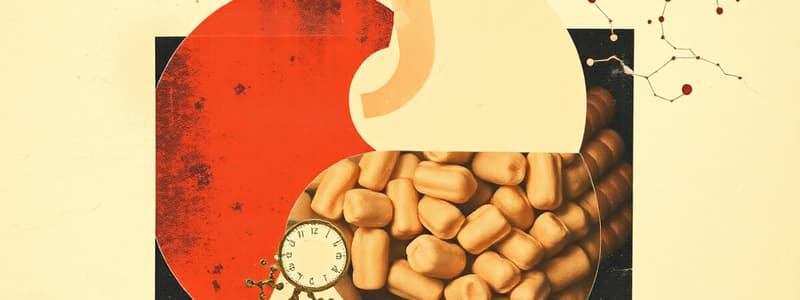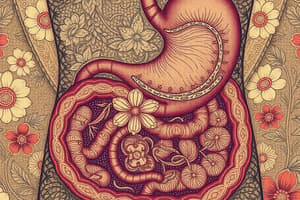Podcast
Questions and Answers
What is the primary role of enzymes in the digestion process?
What is the primary role of enzymes in the digestion process?
- To convert food into molecules for energy and building blocks.
- To transport nutrients across the intestinal lining.
- To neutralize the acidic environment of the stomach.
- To break down macromolecules into smaller, absorbable units. (correct)
Why are digestive enzymes like trypsin and chymotrypsin secreted as zymogens?
Why are digestive enzymes like trypsin and chymotrypsin secreted as zymogens?
- To enhance their catalytic activity.
- To facilitate their transport across cell membranes.
- To increase their solubility in the digestive tract.
- To protect the digestive organs from self-digestion. (correct)
Where does protein digestion initially occur and what is the key enzyme involved?
Where does protein digestion initially occur and what is the key enzyme involved?
- Small intestine; amylase
- Stomach; pepsin (correct)
- Mouth; lysozyme
- Liver; protease
Which of the following best describes how proteins are processed in the stomach to aid in their digestion?
Which of the following best describes how proteins are processed in the stomach to aid in their digestion?
What is the role of peptidases located in the plasma membrane of intestinal cells?
What is the role of peptidases located in the plasma membrane of intestinal cells?
What type of bond does α-amylase target when digesting polysaccharides, and what are the resulting products?
What type of bond does α-amylase target when digesting polysaccharides, and what are the resulting products?
Why does the digestion of carbohydrates by salivary α-amylase have limited effect?
Why does the digestion of carbohydrates by salivary α-amylase have limited effect?
How do enzymes on the surface of intestinal cells contribute to carbohydrate digestion?
How do enzymes on the surface of intestinal cells contribute to carbohydrate digestion?
What is the role of bile salts in the digestion of lipids?
What is the role of bile salts in the digestion of lipids?
How do pancreatic lipases facilitate the digestion of lipids?
How do pancreatic lipases facilitate the digestion of lipids?
Which characteristic of lipids presents the biggest challenge for their digestion?
Which characteristic of lipids presents the biggest challenge for their digestion?
What is the primary function of a-dextrinase in carbohydrate digestion?
What is the primary function of a-dextrinase in carbohydrate digestion?
How does the acidic environment of the stomach contribute to protein digestion?
How does the acidic environment of the stomach contribute to protein digestion?
What is the role of pancreatic proteases in protein digestion, and what are the resulting products?
What is the role of pancreatic proteases in protein digestion, and what are the resulting products?
How does the action of pancreatic α-amylase differ from that of intestinal surface enzymes in carbohydrate digestion?
How does the action of pancreatic α-amylase differ from that of intestinal surface enzymes in carbohydrate digestion?
What is the mechanism of action of bile salts in facilitating lipid digestion?
What is the mechanism of action of bile salts in facilitating lipid digestion?
A patient lacks the enzyme lactase. Which disaccharide would they have difficulty digesting?
A patient lacks the enzyme lactase. Which disaccharide would they have difficulty digesting?
Certain weight loss drugs function by inhibiting pancreatic lipase. What is the expected outcome of taking such a drug?
Certain weight loss drugs function by inhibiting pancreatic lipase. What is the expected outcome of taking such a drug?
Which of the following enzymes is responsible for initially breaking down proteins into smaller peptides in the stomach?
Which of the following enzymes is responsible for initially breaking down proteins into smaller peptides in the stomach?
Why is it necessary for pancreatic lipases to act at the surface of lipid droplets rather than throughout the entire lipid volume?
Why is it necessary for pancreatic lipases to act at the surface of lipid droplets rather than throughout the entire lipid volume?
Flashcards
Digestion
Digestion
Process of converting food into molecules for energy or building blocks.
Hydrolases
Hydrolases
Enzymes that catalyze the hydrolysis of chemical bonds.
Zymogens/Proenzymes
Zymogens/Proenzymes
Inactive enzyme precursors that require activation.
Pepsin
Pepsin
Signup and view all the flashcards
Pancreatic Proteases
Pancreatic Proteases
Signup and view all the flashcards
Peptidases
Peptidases
Signup and view all the flashcards
α-Amylase
α-Amylase
Signup and view all the flashcards
Disaccharidases
Disaccharidases
Signup and view all the flashcards
Sucrase
Sucrase
Signup and view all the flashcards
Lactase
Lactase
Signup and view all the flashcards
Pancreatic Lipases
Pancreatic Lipases
Signup and view all the flashcards
Bile Salts
Bile Salts
Signup and view all the flashcards
Study Notes
Digestion Overview
- Digestion is the process of converting food into molecules that can be used for energy or building blocks.
- Different enzymes are responsible for digesting different biomolecules.
- Many digestive enzymes are hydrolases.
- Most digestive enzymes are secreted as inactive zymogens or proenzymes.
- Zymogens are activated by proteolytic cleavage.
Gastric and Pancreatic Zymogens
- Pepsinogen is synthesized in the stomach and becomes pepsin.
- Chymotrypsinogen, trypsinogen, procarboxypeptidase, and proelastase are synthesized in the pancreas.
- Chymotrypsinogen becomes chymotrypsin.
- Trypsinogen becomes trypsin.
- Procarboxypeptidase becomes carboxypeptidase.
- Proelastase becomes elastase.
Protein Digestion
- Protein digestion begins in the stomach, which has an acidic environment with a pH of 1-2.
- The acidic environment denatures proteins by breaking hydrogen and ionic bonds.
- Pepsin begins degrading proteins into fragments in the stomach.
- Pancreatic proteases hydrolyze proteins into small fragments called oligopeptides in the intestine, which continues protein digestion.
- Peptidases in the plasma membrane of intestinal cells further break down oligopeptides into tripeptides, dipeptides, or amino acids.
- Peptidases inside intestinal cells break down tripeptides and dipeptides into amino acids.
Carbohydrate Digestion
- α-amylase in saliva cleaves α-1,4 glycosidic bonds of polysaccharides, beginning carbohydrate digestion.
- Minimal digestion occurs in the mouth because α-amylase is denatured in the stomach.
- Pancreatic α-amylase in the intestine cleaves α-1,4 glycosidic bonds of starch, but not α-1,6 bonds.
- This produces maltose (disaccharide), maltotriose (trisaccharide), and limit dextrin.
- Enzymes on the surface of intestinal cells further break down carbohydrates for absorption.
- α-glucosidase digests maltose, maltotriose, and other oligosaccharides.
- α-dextrinase digests limit dextrin into simple sugars.
- Sucrase breaks down sucrose into glucose and fructose.
- Lactase breaks down lactose into glucose and galactose.
Lipid Digestion
- Most lipids are ingested as triacylglycerols and must be broken down into fatty acids to be absorbed in the intestine.
- Lipids and fatty acids are hydrophobic, which presents a challenge for digestion.
- The stomach converts lipids into an emulsion, which is a mixture of lipid droplets and water.
- Bile salts in the small intestine further emulsify lipids.
- Bile salts are amphipathic molecules made in the liver from cholesterol and secreted by the gallbladder.
- Bile salts insert into lipid droplets to make triacylglycerol more available for enzymes to digest.
- Pancreatic lipases attach to the surface of lipid droplets and digest triacylglycerol.
- Fatty acids and monoacylglycerol are produced from lipid breakdown.
Studying That Suits You
Use AI to generate personalized quizzes and flashcards to suit your learning preferences.


